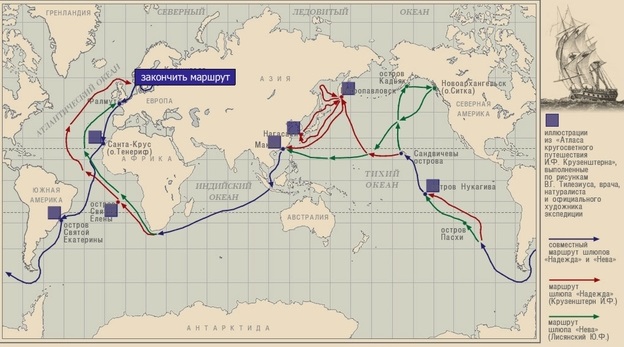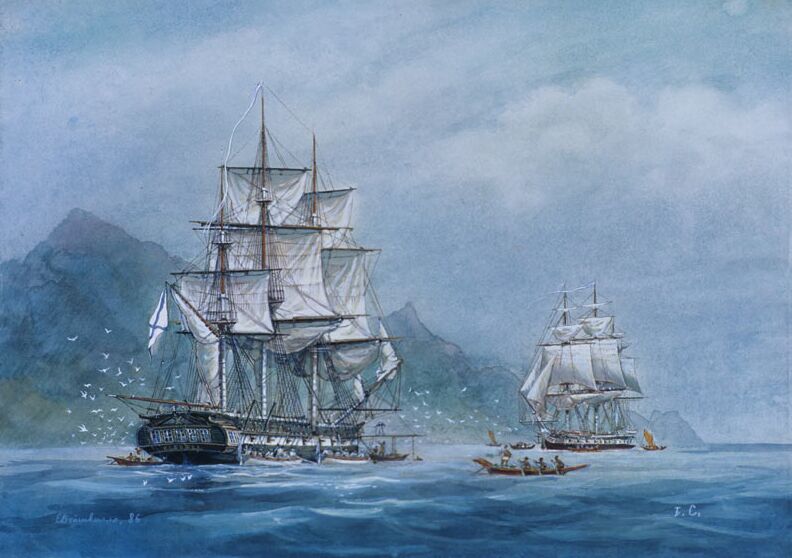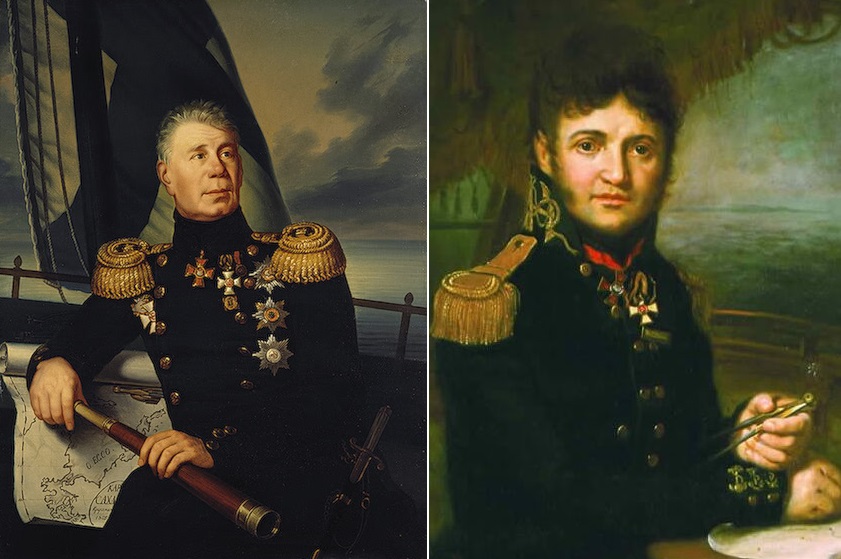Ivan Fedorovich Kruzenshtern and Yuri Fedorovich Lisyansky were combat Russian sailors: both in 1788–1790. participated in four battles against the Swedes. The voyage of Kruzenshtern and Lisyansky is the beginning of a new era in the history of Russian navigation
The purpose of the expedition
 Route and map of the round-the-world expedition of Kruzenshtern and Lisyansky
Route and map of the round-the-world expedition of Kruzenshtern and Lisyansky To make the first round-the-world voyage in the history of the Russian fleet. Deliver-pick up goods from Russian America. Establish diplomatic contacts with Japan. Show the profitability of direct trade in furs from Russian America to China. Prove the benefits of the sea route from Russian America to St. Petersburg in comparison with the land route. Conduct various geographical observations and scientific research along the route of the expedition.
The composition of the expedition
 The expedition started from Kronstadt on July 26 (August 7), 1803. under the direction of , who was 32 years old. The expedition included:
The expedition started from Kronstadt on July 26 (August 7), 1803. under the direction of , who was 32 years old. The expedition included:
- Three-masted sloop "Nadezhda", with a displacement of 450 tons, a length of 35 meters. Acquired in England specifically for the expedition. The ship was not new, but endured all the difficulties of circumnavigating the world. The total team size is 65 people. Commander - Ivan Fedorovich Kruzenshtern.
- Three-masted sloop "Neva", displacement 370 tons. Bought there specifically for the expedition. He endured all the difficulties of circumnavigating the world, after which he was the first Russian ship to visit Australia in 1807. The total number of the ship's crew is 54 people. Commander - Yury Fedorovich Lisyansky.
Emperor Alexander I personally examined both sloops and allowed them to raise the military flags of the Russian Empire. The emperor took over the maintenance of one of the ships at his own expense, and the Russian-American Company and one of the main inspirers of the expedition, Count N.P. Rumyantsev, took over the costs of operating the other.
The sailors were all Russians - this was Kruzenshtern's condition
Expedition results
And in July 1806, with a difference of two weeks, the Neva and Nadezhda returned to the Kronstadt raid, making the whole trip in 3 years 12 days. Both of these sailboats, like their captains, have become world famous. The first Russian round-the-world expedition was of great scientific importance on a world scale. The studies conducted by Kruzenshtern and Lisyansky had no analogues.
As a result of the expedition, many books were published, about two dozen geographical points were named after famous captains.
 On the left is Ivan Fedorovich Kruzenshtern. Right - Yuri Fedorovich Lisyansky
On the left is Ivan Fedorovich Kruzenshtern. Right - Yuri Fedorovich Lisyansky Description of the expedition was published under the title "Journey around the world in 1803, 1804, 1805 and 1806 on the ships Nadezhda and Neva, under the command of Lieutenant Commander Kruzenshtern", in 3 volumes, with an atlas of 104 maps and engraved paintings, and has been translated into English, French, German, Dutch, Swedish, Italian and Danish.
But the further fate of the sailboats "Nadezhda" and "Neva" was not very successful. All that is known about the Neva is that the ship visited Australia in 1807. "Hope" also died in 1808 off the coast of Denmark. In honor of the sloop Nadezhda, the Russian training sailing vessel, the frigate Nadezhda, was named. And the name of her truly great captain is the legendary barque Kruzenshtern.
A film about the first round-the-world trip of Russians
The film "Neva" and "Hope". The first Russian voyage around the world. Channel "Russia"
Filming took place in locations associated with the expedition. These are 16 geographical points - from Alaska to Cape Horn. The viewer will get a clear opportunity to assess the magnitude of the accomplishments of Russian sailors. Filming also took place on the sailing ship Kruzenshtern. Instruments, household items, maritime traditions - everyone will be able to imagine themselves as a participant in the campaign, feel the hardships that have fallen to their lot.
For the first time, engravings made by members of the expedition and brought to life with the help of computer graphics will be shown. Some scenes were filmed in specially built pavilions and stylized as a movie from the beginning of the 20th century. For the first time, diaries of participants in the voyage will also be heard: they are read in the film by the peers of the heroes - famous actors.
The narrative of the journey is not limited to the historical film genre. The description of the voyage is interspersed with a story about today's most important stopping points of the expedition.
